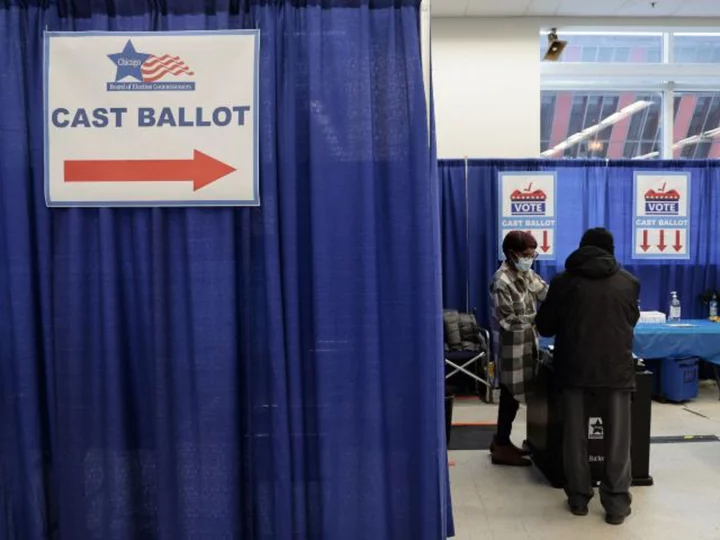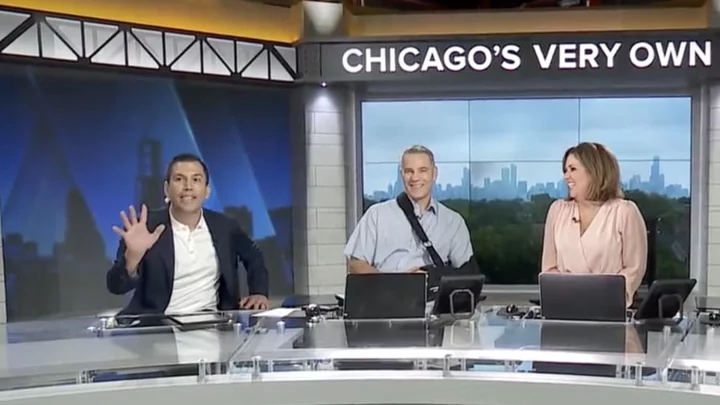Demographic change continued to chip away at the cornerstone of the Republican electoral coalition in 2022, a new analysis of Census data has found.
White voters without a four-year college degree, the indispensable core of the modern GOP coalition, declined in 2022 as a share of both actual and eligible voters, according to a study of Census results by Michael McDonald, a University of Florida political scientist who specializes in electoral turnout.
McDonald's finding, provided exclusively to CNN, shows that the 2022 election continued the long-term trend dating back at least to the 1970s of a sustained fall in the share of the votes cast by working-class White voters who once constituted the brawny backbone of the Democratic coalition, but have since become the absolute foundation of Republican campaign fortunes.
As non-college Whites have receded in the electorate over that long arc, non-White adults and, to a somewhat lesser extent, Whites with at least a four-year college degree, have steadily increased their influence. "This is a trend that is baked into the demographic change of the country, so [it] is likely going to accelerate over the next ten years," says McDonald, author of the recent book "From Pandemic to Insurrection: Voting in the 2020 Presidential Election."
From election to election, the impact of the changing composition of the voter pool is modest. The slow but steady decline of non-college Whites, now the GOP's best group, did not stop Donald Trump from winning the presidency in 2016 -- nor does it preclude him from winning it again in 2024. And, compared to their national numbers, these non-college voters remain a larger share of the electorate in many of the key states that will likely decide the 2024 presidential race (particularly Michigan, Pennsylvania and Wisconsin) and control of the Senate (including seats Democrats are defending in Montana, Ohio and West Virginia.)
But even across those states, these voters are shrinking as a share of the electorate. And McDonald's analysis of the 2022 results shows that the non-college White share of the total vote is highly likely to decline again in 2024, while the combined share of non-Whites and Whites with a college degree, groups much more favorable to Democrats, is virtually certain to increase. The political effect of this decline is analogous to turning up the resistance on a treadmill: as their best group shrinks, Republicans must run a little faster just to stay in place.
Especially ominous for Republicans is that the share of the vote cast by these blue-collar Whites declined slightly in 2022 even though turnout among those voters was relatively strong, while minority turnout fell sharply, according to McDonald's analysis. The reason for those seemingly incongruous trends is that even solid turnout among the non-college Whites could not offset the fact that they are continuing to shrink in the total pool of eligible voters, as American society grows better-educated and more racially diverse.
Given that minority turnout fell off, the fact that the non-college White share of the total 2022 vote still slightly declined "has to be a huge cause for concern for Republicans at this point," says Tom Bonier, chief executive of TargetSmart, a Democratic political targeting firm. If more of the growing pool of eligible minority voters turn out in 2024, he says, "it is not unreasonable to expect" that the non-college White voters so critical to GOP fortunes could experience an even "steeper decline" in their share of the total votes cast next year.
That prospect remains a central concern for the dwindling band of anti-Trump Republicans who fear that the former president has dangerously narrowed the GOP's appeal by identifying it so unreservedly with the cultural priorities and grievances of working-class White voters, many of them older and living outside of the nation's largest and most economically productive metropolitan areas.
McDonald's "data support what is self-evident: that Trumpism peaked in 2016, and that it leads to a dead end," says former US Rep. Carlos Curbelo, a Florida Republican. "We saw this in 2018 when Republicans lost the House; we saw it in 2020 when they lost the presidency and the Senate, and we saw it in last year when Republicans were supposed to have big gains in both chambers and [did not]. All of these failures can be attributed to Trumpism. These data just confirm what is visible to the naked eye."
Cornell Belcher, a Democratic pollster, says these slow but steady long-term changes in the electorate leave him convinced that the ceiling for Trump's potential support in 2024 is no more than 46% of the vote. But Democrats, he believes, still face the risk that the clear majority in the electorate opposed to Trumpism will not turn out in sufficient numbers or splinter to third-party options if they do. Both dangers, he argues, are most pronounced for the diverse younger generations that have never found President Joe Biden very inspiring and have not received sufficient messaging and organizing attention from Democrats.
The political impact of those younger voters, he warns, could be blunted by the proliferation of red state laws making it more difficult to vote and Democrats focusing too much "on chasing this mythical [White] swing voter that doesn't look like that Millennial or Gen Z voter we are relying on."
Overall voter turnout in 2022 was high compared to almost all previous midterms, but below the peak reached in 2018, when a greater share of eligible voters turned out than in any midterm election since 1914, according to McDonald's calculations.
Turnout last year fell most sharply among minorities: while 43% of all eligible non-White voters showed up in 2018, that slipped to just 35% last year, McDonald calculates. Turnout among eligible college-educated White voters also dropped from an astronomical 74% in 2018 to just over 69% last year. White voters without a four-year college degree actually came closest to matching their elevated 2018 performance, slipping only slightly from just over 45% then to about 43% last year.
But turnout is only one of the two factors that shape how large a share of actual voters each group comprises, which is the number that really matters in determining election outcomes. The other factor is how large a share of the pool of potential eligible voters each group represents. Turnout, in effect, is the numerator and the share of eligible voters the denominator that combined produce the share of the total vote each group casts during every election.
As McDonald found, the long-term trends in the eligible voter pool -- the denominator in our equation -- continued unabated in 2022. Whites without a college degree fell to just over 41% of eligible potential voters. That was down 3.2 percentage points from their share of the eligible voter population in 2018 -- which was itself down exactly 3.2 percentage points from their share in 2014. In turn, from 2014 to 2022, college-educated White voters slightly increased their share of the eligible voter pool and minorities significantly increased from 30.5% then to nearly 35% now.
Netting together both the turnout results and these shifts in the eligible voter pool, McDonald found that working-class White voters in 2022 declined as a share overall, whether compared either to the last few midterm elections or the most recent presidential contests.
In 2022, Whites without a college degree cast 38.3% of all votes, he found. That was down from 39.3% in 2018 and more than 43% in 2014, according to his calculations. That finding also represented a continued decline from just over 42% of the vote when Trump won the 2016 presidential election and 39.9% in 2020 -- the first time non-college Whites had fallen below 40% of the total presidential electorate in Census figures.
Whites with at least a four-year college degree were the big gainers in 2022: McDonald found they cast nearly 36% of all votes last year, compared to a little over-one-third in both 2018 and 2014 and a little less than that in the 2020 presidential year. Burdened by lower turnout, the non-White share of the total vote slipped to just over one-fourth, down slightly from 2018, but still higher than in the 2014 midterms. The minority share of the total vote was considerably larger in 2020, reaching nearly three-in-ten in Census figures.
All of this extends very consistent long-term trends. Census data analyzed by the non-partisan States of Change project show that non-college Whites have fallen from around two-thirds of the total vote under Ronald Reagan, to about three-fifths under Bill Clinton, to less than half under Barack Obama, to the current level of just under two-fifths. Over those same decades, college-educated Whites have grown from about two-in-ten to three-in-ten voters, while minorities have increased from a little over one-in-ten then to nearly three-in-ten now.
Other respected data sources differ on the share of the total vote comprised by these three big groups: the Pew Validated Voter study and the estimates by Catalist, a Democratic targeting firm, both put the share of the vote cast in 2020 by non-college Whites slightly higher, in the range of 42-44%.
But both also show the same core pattern as the Census results do, with the share of the total vote cast by those non-college Whites declining by about two percentage points every four years. The Edison Research exit polls conducted for a consortium of media organizations, including CNN, changed its methodology in a way that makes long-term comparisons impossible. But, similarly to McDonald, the exits found the non-college White share of the total vote declining to 39% in 2022 from 41% in 2018, with minorities also slightly falling over that period, and college-educated Whites growing.
The trend lines that McDonald documented for last year suggest it's a reasonable prediction that non-college Whites will again decline as a share of total voters by two points over the period from 2020 to 2024. That would push their share of the national 2024 vote down to below 38%, with more minority voters likely filling most of that gap and the college-educated Whites growing more modestly to offset the rest.
McDonald says the basic dynamic reconfiguring the voting pool is that many Baby Boomers and their elders are aging out of the electorate. That's both because more of them are dying or they are reaching an advanced age where turnout tends to decline, either for infirmity or other obstacles. Those older generations are preponderantly White (about three-fourths of seniors are White), and fewer have college degrees, which were not as essential to economic success in those years, McDonald points out. Meanwhile, a larger share of young adults today hold four-year degrees, and the youngest generations aging into the electorate every two years are far more racially diverse. According to calculations by William Frey, a demographer at the Brookings Metro think tank, young people of color now comprise almost exactly half of all Americans who turn 18 and age into the electorate each year.
"We are right now at the teetering edge of the influence of the baby boomers," says McDonald. "They are just starting to enter those twilight years in their turnout rates, while other [more diverse] groups are maturing. So we are right at that cusp -- that critical point of where things are going to start changing."
The impact of these changes on the outcomes of elections, as McDonald says, is very incremental, "like the proverbial frog in the boiling water." One way to understand that dynamic is to assume that Whites without a college degree on the one hand, and minorities and college-educated Whites on the other, all split their vote at roughly the same proportions as they have in recent elections. If the former group declines as a share of the electorate by two points from 2020-2024 and the latter groups increase by an equal amount, that change alone would enlarge Biden's margin of victory in the two-party vote from 4.6 percentage points to 5.8, Bonier calculates. Republicans would need to increase their vote share with some or all of those groups just to get back to the deficit Trump faced in 2020 -- much less to overcome it.
Ruy Teixeira, a long-time Democratic electoral analyst who has become a staunch critic of his party, argues exactly that kind of shift in voting preferences could offset the change in the electorate's composition -- and create a real threat for Biden. Even though Biden is aggressively highlighting his efforts to create blue-collar jobs through "manufacturing and infrastructure projects that are starting to get off the ground," Teixiera recently wrote, a "sharp swing against the incumbent administration by White working-class voters seems like a very real possibility."
Teixeira, now a nonresident senior fellow at the conservative American Enterprise Institute, also maintains Democrats face the risk Republicans can extend the unexpected gains Trump registered in 2020 with non-White voters without a college degree, especially Hispanics.
Curbelo, the former congressman, shares Teixeira's belief that Democratic liberalism on some social issues like crime is creating an opening for Republicans to gain ground among culturally conservative Hispanics. "If they are not careful, they can jeopardize their potential gains from Republicans doubling down on Trumpism by alienating themselves from minority voters who may identify with some of the [Democrats'] economic policies but who do not necessarily identify with the party's victimhood narrative about minorities," Curbelo says.
Still, Curbelo warns that Republicans are unlikely to achieve the gains possible with minority voters so long as they are stamped so decisively by Trump's polarizing image. And polling has consistently found that while many non-college Hispanic voters hold more moderate views on social issues than college-educated White liberals, those minority voters are not nearly as conservative as core GOP groups, like blue-collar Whites or evangelical Christians.
As Teixeira has forcefully argued in recent years, such demographic change doesn't ensure doom for Republicans or success for Democrats. Among other things, that change is unevenly distributed around the country, and the small state bias of both the Electoral College and the two-senators-per-state rule magnifies the influence of sparsely populated interior states where these shifts have been felt much more lightly.
Yet, even so, the long-term change in the electorate's composition, along with the Democrats' growing strength among white-collar suburban voters, largely explains why the party has won the popular vote in seven of the past eight presidential elections -- something no party has done since the formation of the modern party system in 1828.
And even though Whites without a college degree exceed their share of the national vote in the key Rust Belt battlegrounds of Michigan, Pennsylvania and Wisconsin, their share of the vote is shrinking along the same trajectory of about 2-3 points every four years in those states too, according to analysis by Frey. Meanwhile, in the Sun Belt battlegrounds of Georgia, Arizona and Nevada, more rapid growth in the minority population means that blue-collar Whites will likely comprise a smaller portion of the eligible voter pool than they do nationally.
Trump, with the exception of his beachhead among blue-collar minorities, has now largely locked the GOP into a position of needing to squeeze bigger margins out of shrinking groups, particularly non-college Whites. It's entirely possible that Trump or another Republican nominee can meet that test well enough to win back the White House in 2024, especially given the persistent public disenchantment with Biden's performance. But McDonald's 2022 data shows why relying on a coalition tilted so heavily toward those non-college Whites becomes just a little tougher for the GOP in each presidential race.
While Trump or another Republican certainly can win in 2024, Bonier says, "he has reshaped the party in such a way that they have a very narrow path to victory."









